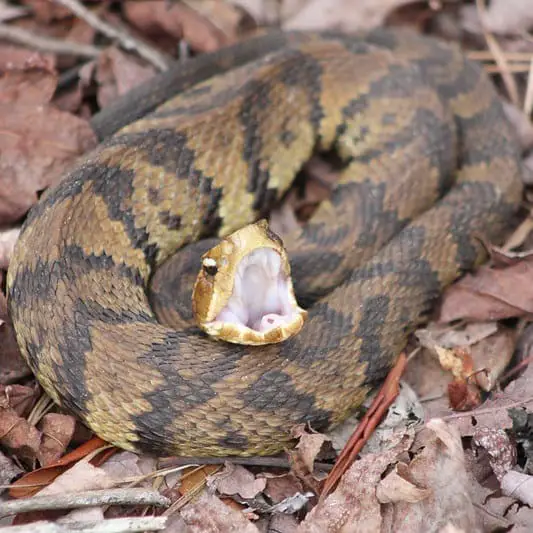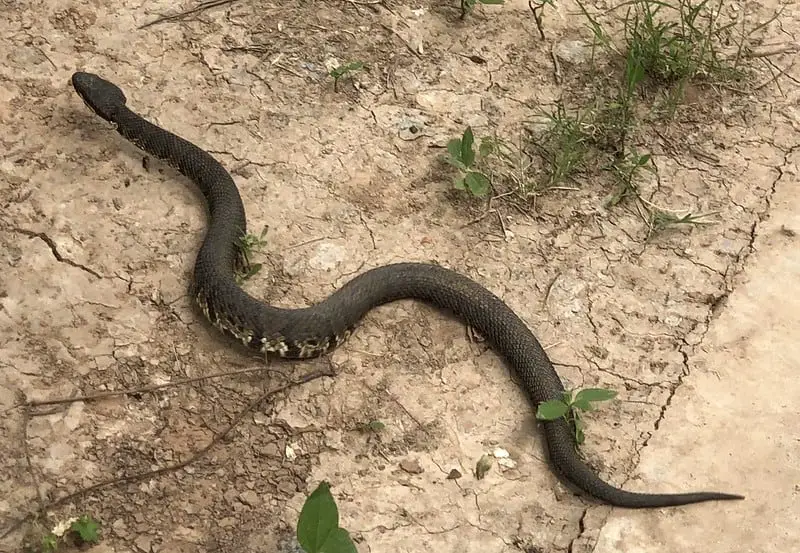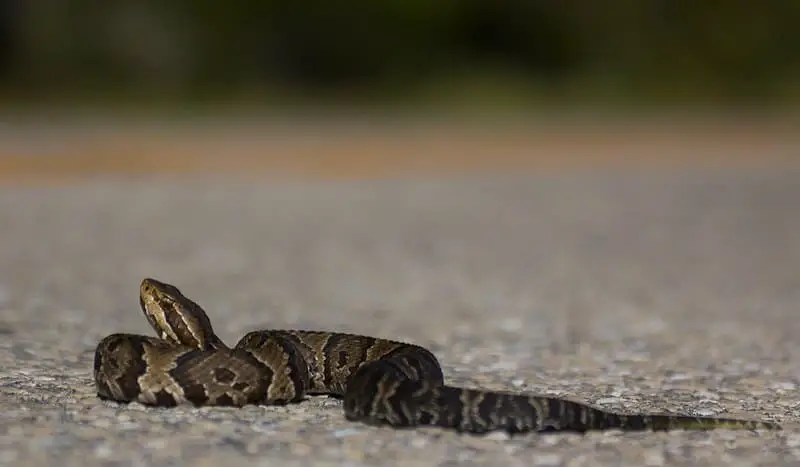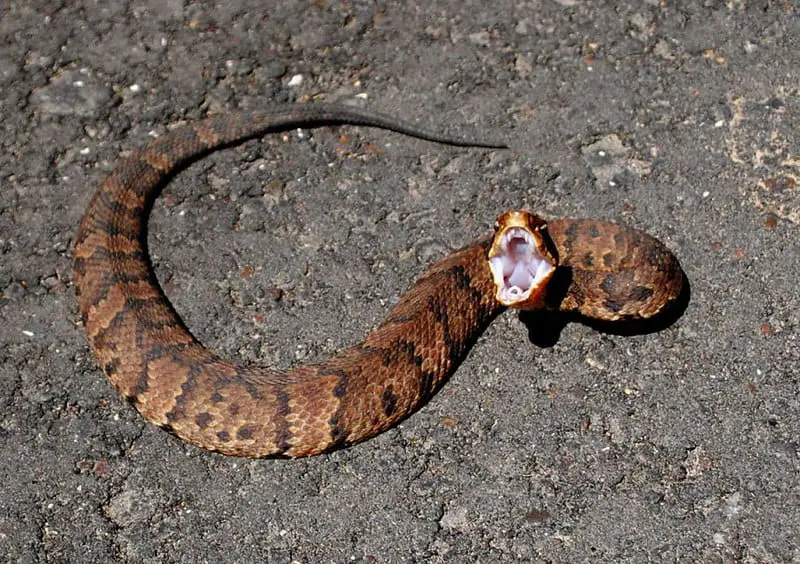Agkistrodon piscivorus, the cottonmouth or water moccasin is a venomous snake that can be found throughout the Eastern United States. The usually brown snake with darker brown blotches lives around water and is a great swimmer. When it feels threatened, it opens its mouth as a threat display. The large white inner mouth have earned it the common name cottonmouth snake.

Description
The basic color of the snake’s back is black, gray, yellow-brown, dark brown or dark olive green. Depending on the subspecies, it has an average of 12 to 13 dark brown to black crossbands on its back. These bands are often bordered by a dark color. The center is often as light as the ground color of the body. With increasing age, these blotches become more and more indistinct. Especially in the southeast of its range (Florida and Georgia), old specimen can become solid dark colored. In general, representatives of the species in the eastern and southeastern part of the distribution range are paler in color and at the same time larger than those in the western part of the range.

Juvenile snakes have a more conspicuous appearance. They have a clear, dark and light pattern and a light yellow or green tail tip. When they get older, the pattern fades and the light tail coloration changes from light green to the dark ground color of the rest of the body. Juvenile snakes use their tail as a lure for prey animals.
Within its natural range, the cottonmouth snake can be confused with the venomous and closely related copperhead (Agkistrodon contortrix). However, the copperhead snake lacks the postocular stripe (a broad stripe behind the eye). Another similar looking snake is the nonvenomous common water snake. However, they are thinner, have a flatter head and don’t have any facial pits.
Subspecies
There are three subspecies of the cottonmouth snake:
- Agkistrodon piscivorus piscivorus (Eastern cottonmouth): Along the east coast of the USA from Virginia to Alabama. The upper side and the head-sides are pale-brown; in the age, a Bänderung of the upper side remains.
- Agkistrodon piscivorus conanti (Florida cottonmouth): Florida and southern part of Georgia. Upper side and head sides are very dark, almost black; in adult individuals the banding on the upper side is weak or washed out.
- Agkistrodon piscivorus leucostoma (Western cottonmouth): From the west of the state of Texas via eastern Oklahoma and Missouri to the south of Illinois, to the east it reaches Kentucky, Tennessee and Alabama. Upper side and head sides are often very dark brown or black in both adults and young animals; the banding is often hardly recognizable in adult individuals.
Size
The cottonmouth snake is the larger species than its relative, the copperhead. They reach and average length of over 30 inches (80 cm). Males are usually larger than females. Especially in the eastern part of their range, individual specimen can get considerably larger than the average. The largest ever recorded cottonmouth was 74 inches (188 cm) long. The average weight of a female copperhead is 8 ounces (230 g) and the average weight of an adult male is around 15 ounces (400 g).

Hunting Behavior
The majority of the diet of the cottonmouth snake consists of fish, frogs and salamanders. Especially at nighttime, the snake hunts sleeping fish in shallow waters. The cottonmouth also preys on a wide range of other animals like mammals, lizards as well as snakes (including its own species).
Juvenile cottonmouth snakes use their yellow-colored tail tip as a lure to attract prey animals. As soon as an unsuspecting animal looking for a juicy yellow caterpillar gets in striking range, the young snake grabs the prey with a strong bite.
Bite
The cottonmouth has a strong cytotoxic venom that can lead to severe tissue destruction. A bite causes severe pain, redness, swelling and necrosis around the bite. The toxin also has a haemolytic and anticoagulant effect, in severe cases it can completely stop blood clotting. Overall, the venom of the cottonmouth is stronger than that of its close relative, the copperhead, but considerably weaker than the venom of most rattlesnakes.
The cottonmouth is a relatively aggressive snake. Whenever it feels threatened, it widely opens its mouth to warn any intruder or attacker. The large white mouth that is often visible for anyone who runs into the snake in the wild has lead to its common name, cottonmouth.

However, the tissue destruction caused by a bite can be irreversible and associated with a permanent loss of function of the affected limb. Like other pit vipers, this species does not necessarily inject its venom with every bite. But every you should take every bite seriously and seek medical attention immediately. Even if no immediate envenomation is apparent.
Habitat
Cottonmouth snakes live in swamps, wetlands and around rivers. They are often seen on riverbanks or swimming in rivers. Especially when they are found in or near water, they are even more easily confused with the similar-looking common watersnake.
Cottonmouth range in the USA
The cottonmouth water moccasin can be found in the Southeastern United States. In can be found in the following states: Alabama, Arkansas, Florida, Georgia, southern Illinois, southern Indiana, Kentucky, Louisiana, Mississippi, Missouri, North Carolina, Oklahoma, South Carolina, Texas, Virginia, western and central Tennessee and extreme southeastern Kansas.
Scientific classification of Agkistrodon piscivorus
- Kingdom: Animalia
- Phylum: Chordata
- Class: Reptilia
- Order: Squamata
- Suborder: Serpentes
- Family: Viperidae
- Genus: Agkistrodon
- Species: Agkistrodon piscivorus
Other common names
Next to its most common name cottonmouth snake, Agkistrodon piscivorus is known under a wide range of other common names. The most widely known are: water moccasin, black water viper, gaper, water rattlesnake, water viper and various more combinations.